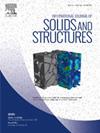Dynamic properties and deep learning-based optimal design of hybrid shape-memory-alloy sandwich beams
IF 3.4
3区 工程技术
Q1 MECHANICS
International Journal of Solids and Structures
Pub Date : 2025-01-23
DOI:10.1016/j.ijsolstr.2025.113223
引用次数: 0
Abstract
This study explores the design of sandwich composite materials integrating a shape-memory-alloy core. The energy-dissipating property of shape memory alloys (SMAs), associated with their underlying phase transformation, can help enhance the overall damping capacity while maintaining required stiffness performance. However, the design of the core poses significant challenges due to the highly nonlinear behavior of SMAs. In this work, an optimization framework for the design of nonlinear sandwich beams with SMA cellular cores is presented. The approach relies on a combination of a deep learning (DL)-based surrogate model with an evolutionary optimizer. While trained on a limited number of configurations, the surrogate model can accurately predict the nonlinear response of the SMA sandwich beam (SSB) integrating an arbitrary core design, accelerating the nonlinear numerical simulations by six orders of magnitude. Then, by incorporating the surrogate model into an evolutionary algorithm, the multiobjective optimization problem can be solved under geometric constraints. In particular, optimal core designs are sought to maximize damping while simultaneously satisfying stiffness and SMA volume requirements. The obtained optimal configurations are then validated via full field finite element analysis, showing that the proposed framework can effectively deliver SSB designs with tailored performance.
求助全文
约1分钟内获得全文
求助全文
来源期刊
CiteScore
6.70
自引率
8.30%
发文量
405
审稿时长
70 days
期刊介绍:
The International Journal of Solids and Structures has as its objective the publication and dissemination of original research in Mechanics of Solids and Structures as a field of Applied Science and Engineering. It fosters thus the exchange of ideas among workers in different parts of the world and also among workers who emphasize different aspects of the foundations and applications of the field.
Standing as it does at the cross-roads of Materials Science, Life Sciences, Mathematics, Physics and Engineering Design, the Mechanics of Solids and Structures is experiencing considerable growth as a result of recent technological advances. The Journal, by providing an international medium of communication, is encouraging this growth and is encompassing all aspects of the field from the more classical problems of structural analysis to mechanics of solids continually interacting with other media and including fracture, flow, wave propagation, heat transfer, thermal effects in solids, optimum design methods, model analysis, structural topology and numerical techniques. Interest extends to both inorganic and organic solids and structures.

 求助内容:
求助内容: 应助结果提醒方式:
应助结果提醒方式:


